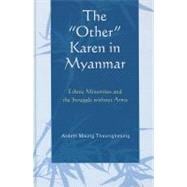
Note: Supplemental materials are not guaranteed with Rental or Used book purchases.
Purchase Benefits
What is included with this book?
| Acknowledgments | p. ix |
| Introduction Growing up in Burma-a Personal Account | p. xiii |
| The International Phenomenon of the "Silent Minority" | p. xvii |
| Theme, Approach, and Method of the Book | p. xx |
| Acronyms | p. xxxi |
| Who are the "Other" or "Quiet" Minorities? | p. 1 |
| The Political Significance of the "Other" Minorities | p. 3 |
| Bringing the "Other" Minorities into the Study of Ethnic Politics | p. 7 |
| The Emergence of the Karen Ethno-nationalistic Movement | p. 19 |
| The Construction of Karen Ethno-nationalist Identities | p. 20 |
| The "Martial Race" | p. 31 |
| The Myaungmya Incident | p. 34 |
| The Case for an Independent Karen State | p. 37 |
| The "Martial Race" Returns | p. 42 |
| Saw Ba U Gyi and the Insein Ceasefire Talks | p. 46 |
| KNU in Twenty-First Century Burma | p. 53 |
| Conclusion | p. 58 |
| Kawthoolei Karen: A Fragmented Constituency | p. 63 |
| Government-Controlled zones | p. 65 |
| Rebel-Controlled and Contested Zones | p. 74 |
| The Refugees | p. 80 |
| The Diaspora | p. 84 |
| Conclusion | p. 85 |
| The "Rebel" and the "Accommodator" | p. 91 |
| The Early Stages of the Armed Resistance Movement | p. 93 |
| Profile of Prominent Karen Political Leaders at KNU and KYO in 1945-1949 | p. 101 |
| The Later Stages of the Armed Rebellion | p. 105 |
| Divide and Rule | p. 107 |
| Places of Residence | p. 109 |
| Competing Identities | p. 116 |
| Lack or Perceived Lack of Alternatives | p. 117 |
| Conclusion | p. 121 |
| The "Other" Ethno-nationalities in Myanmar/Burma | p. 127 |
| A Changing Political Landscape in SPDC and Post-SPDC Periods | p. 128 |
| The "Other" Nationalities in Burma/Myanmar | p. 130 |
| Self-employed, Low-income Earners and Small-, Medium-, and Large-scale Enterprise Owners | p. 131 |
| Government and Public Sector Employees | p. 132 |
| Private Sector Employees | p. 133 |
| Professionals Working for International Organizations | p. 133 |
| Members of Local NGOs and Community-based Organizations | p. 134 |
| Members of Government-organized Nongovernmental Organizations (GONGOs) | p. 135 |
| Members of Pro-government Parties | p. 135 |
| Members of Opposition Parties | p. 137 |
| Civilians Under the Control of Armed Organizations in Ceasefire and Contested Areas | p. 138 |
| Three Patterns of Civilian Politics among Ethnic Minorities | p. 139 |
| Activities Supporting the Status Quo | p. 139 |
| Activities Transforming or Undermining the Status Quo | p. 143 |
| Promoting Ethnic Identity and Addressing Humanitarian Needs | p. 147 |
| Conclusion | p. 153 |
| Conclusion: The "Other" Ethnonationalities in Comparative Perspective | p. 161 |
| Competing Identities | p. 161 |
| Divide-and-Rule Strategies | p. 168 |
| The Role of the "Other" Minorities in Ethnic Politics | p. 172 |
| Conclusion | p. 176 |
| Bibliography | p. 178 |
| Index | p. 191 |
| About the Author | p. 199 |
| Table of Contents provided by Ingram. All Rights Reserved. |
The New copy of this book will include any supplemental materials advertised. Please check the title of the book to determine if it should include any access cards, study guides, lab manuals, CDs, etc.
The Used, Rental and eBook copies of this book are not guaranteed to include any supplemental materials. Typically, only the book itself is included. This is true even if the title states it includes any access cards, study guides, lab manuals, CDs, etc.